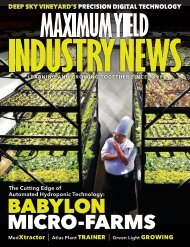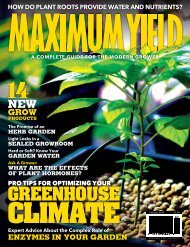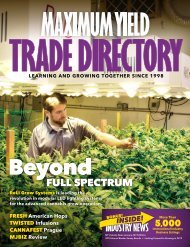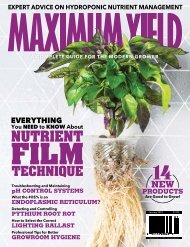Maximum Yield Canada July/August 2017
While hydroponics is unlikely to overtake traditional agriculture economically anytime soon—current US annual crop production is estimated at $143 billion while hydroponics is valued at a mere $600 million—it’s not so much as how much is being grown but where. Today, nobody knows what society will be like in 2100. We hope it will be a peaceful, healthy, and happy place.
While hydroponics is unlikely to overtake traditional agriculture economically anytime soon—current US annual crop production is estimated at $143 billion while hydroponics is valued at a mere $600 million—it’s not so much as how much is being grown but where. Today, nobody knows what society will be like in 2100. We hope it will be a peaceful, healthy, and happy place.
You also want an ePaper? Increase the reach of your titles
YUMPU automatically turns print PDFs into web optimized ePapers that Google loves.
“MEASURING LST IS like taking<br />
a person’s temperature with a<br />
thermometer under their tongue.”<br />
Note that the leaf surface temperature<br />
is affected by, but not equivalent to, the<br />
ambient air temperature in the growing<br />
environment. Leaves can be cooled through<br />
evaporation occurring in open pores<br />
(stomata) in the leaf that allow gas exchange,<br />
and are warmed by absorbed but unused<br />
light, whether from artificial or natural sources.<br />
Leaf surface temperature is almost always<br />
different than ambient air temperature.<br />
WHAT IS THE IDEAL LEAF SURFACE TEMPERATURE?<br />
So, what is the ideal leaf surface temperature for plants? This<br />
is unfortunately a question without a simple answer as many<br />
factors influence the ideal.<br />
Multiple types of metabolic reactions exist within every<br />
plant, and each has a different optimal temperature range.<br />
Primary metabolism (photosynthesis) is obviously the most<br />
important; without it, the plant will not survive. Optimal<br />
temperatures for desirable secondary metabolites must<br />
be considered as well, especially if the plant is grown<br />
specifically for the secondary metabolites.<br />
The optimal leaf temperature range for photosynthesis<br />
depends on the type of plant and concentrations of CO 2.<br />
Arctic- and alpine-adapted plants typically require cooler<br />
temperatures, while desert-adapted and plants using C4<br />
photosynthesis prefer it warmer. (There are two slightly<br />
different chemical reactions for photosynthesis, called C3 and<br />
C4; the variant a plant uses is determined genetically.) Most<br />
growers also know they can turn up the temperature when<br />
running CO 2, since CO 2 supplementation will generally raise<br />
the optimal photosynthesis temperature. Thus, the ideal LST<br />
for photosynthesis is dependent on environmental conditions<br />
as well as the type of plant.<br />
Secondary metabolic reactions can have a huge range<br />
of optimal temperatures; many plants have even evolved<br />
responses specifically triggered by exposure to cold or hot<br />
temperatures to better adapt to their surroundings. For<br />
example, some plants produce proteins with anti-freeze<br />
properties when exposed to cold.<br />
In short, the ideal leaf surface temperature depends on<br />
the species/variety of the plant, overall environmental<br />
conditions, as well as what the plant is being grown for. Only<br />
experimentation can determine an ideal range for LST for a<br />
specific plant variety in a specific set of conditions.<br />
grow cycle<br />
49

















